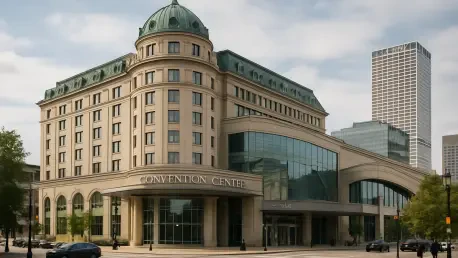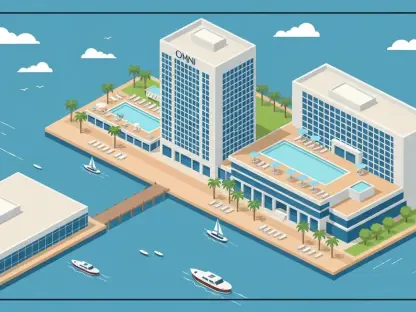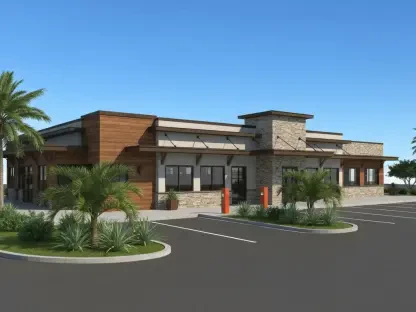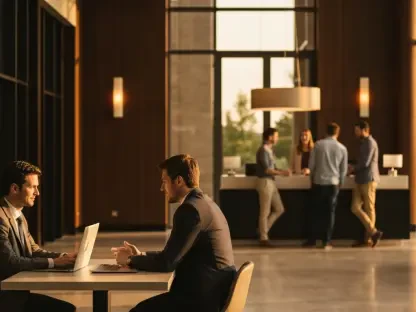What happens when a city’s convention future hinges on a single strategic move in its hospitality sector? In downtown Milwaukee, a transformation is underway that could redefine the landscape for travelers and event planners alike, as Marcus Hotels & Resorts, a division of Marcus Corp., prepares to unveil The Marc Hotel. This independent 175-room property, carved from the west wing of the Hilton Milwaukee, is set to open in early 2026. This isn’t just a hotel launch—it’s a calculated step toward sustaining Milwaukee’s status as a convention powerhouse.
A Pivotal Moment for Milwaukee’s Convention Scene
Milwaukee thrives on its ability to host large-scale events, drawing thousands of visitors annually to the Baird Center and beyond. Yet, the challenge of maintaining enough hotel rooms to meet demand has loomed large, especially with whispers of potential taxpayer-subsidized competitors on the horizon. The decision to reopen a portion of the Hilton Milwaukee as The Marc Hotel addresses this gap head-on, promising a fresh option for convention attendees while reinforcing the city’s economic backbone. This initiative isn’t merely about adding beds—it’s about securing Milwaukee’s reputation as a go-to destination for major gatherings.
The significance of this move extends beyond numbers. It reflects a deeper commitment to adaptive reuse, ensuring that existing infrastructure serves current needs without overextending resources. With direct connectivity to the Baird Center, The Marc Hotel positions itself as a linchpin in the city’s strategy to attract bigger events, supporting local businesses and tourism in the process. This development marks a critical juncture, balancing immediate demand with long-term vision in a competitive market.
The Strategy Fueling This Transformation
Behind the rebirth of The Marc Hotel lies a meticulously crafted plan by Marcus Hotels & Resorts. The name itself pays homage to the property’s history, echoing its days as the Marc Plaza Hotel after Marcus Corp. acquired the original Schroeder Hotel in 1972. This nod to heritage blends seamlessly with a modern outlook, creating a brand that resonates with both nostalgia and innovation for guests stepping through its doors.
The hotel’s design as a limited-service property targets a specific audience—convention-goers and travelers seeking convenience over luxury. A dedicated entrance on North 6th Street ensures easy access to the Baird Center, streamlining the experience for event attendees. Moreover, the strategy includes minimal investment in updates, focusing on essential functionality rather than lavish overhauls, a move that keeps costs in check while maintaining competitiveness in an uncertain economic climate.
Flexibility remains a cornerstone of this project. The west wing’s transformation preserves options for future expansion, potentially scaling up to a 1,000-room headquarters hotel if demand surges in the coming years. Alternatively, if new competition emerges, the space can be repurposed, safeguarding against market oversaturation. This forward-thinking approach underscores a balance between immediate utility and strategic preparedness.
Leadership Insights on Balancing Growth and Caution
Gregory S. Marcus, CEO of Marcus Corp., has articulated a clear vision for this endeavor. “The goal is to bolster Milwaukee’s convention growth while staying mindful of economic risks,” he stated, emphasizing the importance of keeping the west wing operational as a hotel. His perspective highlights a pragmatic stance—meeting the city’s urgent needs for room supply without committing to costly renovations amid potential market shifts.
Industry experts echo this sentiment, noting that adaptability is increasingly vital in urban hospitality markets. Milwaukee’s competitive landscape demands such caution, especially with the specter of subsidized competitors looming. The leadership’s focus on guest convenience paired with fiscal restraint sets a precedent for how companies can navigate growth in challenging environments, ensuring that resources are allocated with precision.
This cautious optimism is evident in the project’s scope. By prioritizing essential updates over extensive redesigns, Marcus Hotels & Resorts demonstrates a commitment to efficiency. The approach not only supports the city’s convention economy but also positions the company to pivot swiftly should market dynamics change in the years ahead.
Guest Benefits and Community Impact
For travelers and event planners, The Marc Hotel offers tangible advantages that make it a standout choice. Its prime location, directly linked to the Baird Center, eliminates logistical hurdles for convention attendees, providing a seamless transition from event spaces to accommodations. This connectivity is poised to enhance Milwaukee’s appeal as a host city for national and international gatherings.
Beyond location, the hotel promises a reliable experience despite its limited-service model. Marcus Hotels & Resorts has pledged to uphold quality standards, ensuring guests enjoy a comfortable stay without unnecessary extras. This focus on essentials caters to budget-conscious travelers while maintaining a level of service that aligns with the company’s reputation for excellence.
The broader impact on Milwaukee cannot be overstated. By sustaining room availability, The Marc Hotel helps attract larger events, driving foot traffic to local restaurants, shops, and attractions. This ripple effect strengthens the city’s economic fabric, supporting jobs and fostering growth in the tourism sector. For event organizers planning for 2026 and beyond, this property could become a cornerstone of their logistical strategy.
A Legacy Reimagined for Tomorrow
Looking back, the transformation of the Hilton Milwaukee’s west wing into The Marc Hotel stood as a testament to strategic foresight in a pivotal moment for the city. It addressed an urgent need for hotel capacity while honoring the property’s storied past, weaving history into a modern narrative of progress. The initiative by Marcus Hotels & Resorts showcased how adaptability could turn challenges into opportunities.
Reflecting on the broader implications, this project offered a blueprint for other cities grappling with similar hospitality dilemmas. The balance of minimal investment with maximum utility suggested a sustainable path forward, one that others could emulate. For Milwaukee, it solidified a foundation for future growth, ensuring the convention sector remained robust.
As the dust settled, the focus shifted to monitoring how The Marc Hotel would shape traveler experiences and market dynamics in the years that followed. Stakeholders were encouraged to track its impact on event bookings and local commerce, using these insights to refine strategies. This revival wasn’t just an endpoint—it was a launchpad for ongoing innovation in Milwaukee’s hospitality landscape.









